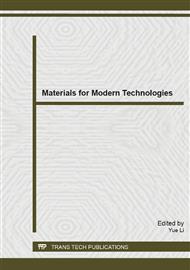p.159
p.167
p.178
p.185
p.190
p.196
p.200
p.204
p.217
Micro-Structural Properties of Zinc Oxide Nano-Particles Synthesized by Bio-Polymeric Templates
Abstract:
Zinc and iron oxide nanoparticles were synthesized using natural bio-polymeric templates viz. cellulose and sodium alginate. Cellulose fibres from different sources viz. filter-and blot-papers, were used as templates for this purpose. The synthesized Zinc oxide nanoparticles were characterized by X-ray diffraction (XRD), fourier transform infra-red spectra (FT-IR), UV-Visible spectrophotomer (UV-Vis) and scanning electron microscopic (SEM) studies. XRD studied confirmed the formation of highly crystalline hexagonal wurtzite phase of ZnO in all the synthesized nanoparticles. The average crystallite sizes of the nanoparticles obtained using different templates, were well below 50 nm. Characteristics of the zinc oxide nanoparticles obtained by template-based techniques were compared with those obtained by co-precipitation technique. Influence of various templates on the characteristics of metal oxide nanoparticles was studied.
Info:
Periodical:
Pages:
190-195
Citation:
Online since:
April 2014
Authors:
Keywords:
Price:
Сopyright:
© 2014 Trans Tech Publications Ltd. All Rights Reserved
Share:
Citation:


